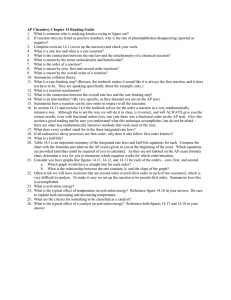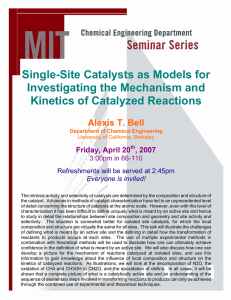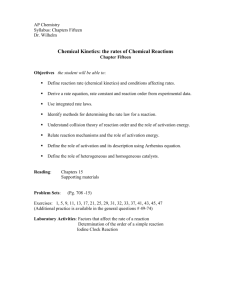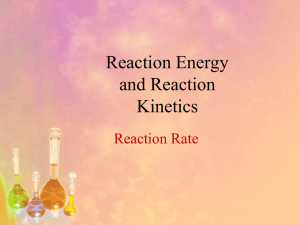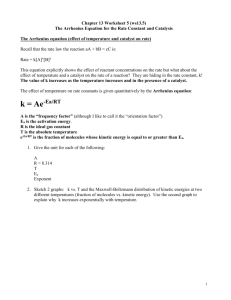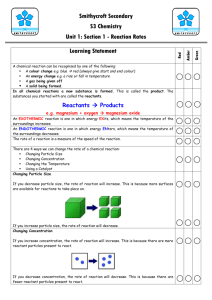Notes: Reaction Kinetics
advertisement
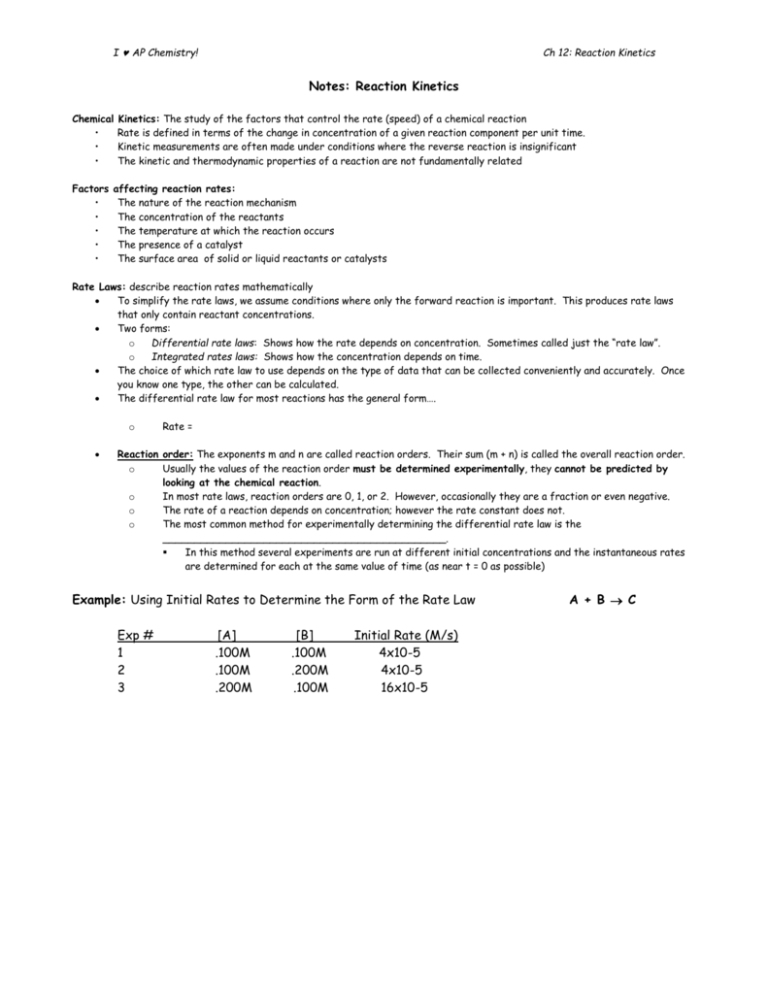
I AP Chemistry! Ch 12: Reaction Kinetics Notes: Reaction Kinetics Chemical • • • Factors • • • • • Kinetics: The study of the factors that control the rate (speed) of a chemical reaction Rate is defined in terms of the change in concentration of a given reaction component per unit time. Kinetic measurements are often made under conditions where the reverse reaction is insignificant The kinetic and thermodynamic properties of a reaction are not fundamentally related affecting reaction rates: The nature of the reaction mechanism The concentration of the reactants The temperature at which the reaction occurs The presence of a catalyst The surface area of solid or liquid reactants or catalysts Rate Laws: describe reaction rates mathematically To simplify the rate laws, we assume conditions where only the forward reaction is important. This produces rate laws that only contain reactant concentrations. Two forms: o Differential rate laws: Shows how the rate depends on concentration. Sometimes called just the “rate law”. o Integrated rates laws: Shows how the concentration depends on time. The choice of which rate law to use depends on the type of data that can be collected conveniently and accurately. Once you know one type, the other can be calculated. The differential rate law for most reactions has the general form…. o Rate = Reaction order: The exponents m and n are called reaction orders. Their sum (m + n) is called the overall reaction order. o Usually the values of the reaction order must be determined experimentally, they cannot be predicted by looking at the chemical reaction. o In most rate laws, reaction orders are 0, 1, or 2. However, occasionally they are a fraction or even negative. o The rate of a reaction depends on concentration; however the rate constant does not. o The most common method for experimentally determining the differential rate law is the _____________________________________________. In this method several experiments are run at different initial concentrations and the instantaneous rates are determined for each at the same value of time (as near t = 0 as possible) Example: Using Initial Rates to Determine the Form of the Rate Law Exp # 1 2 3 [A] .100M .100M .200M [B] .100M .200M .100M Initial Rate (M/s) 4x10-5 4x10-5 16x10-5 A + B C I AP Chemistry! Ch 12: Reaction Kinetics Summary of the Kinetics for Reactions of the Type aA Products That are Zero, First, or Second Order in [A] Zero Order First Order Second Order Rate Law Integrated Rate Law Plot needed to Give a Straight Line Relationship of Rate Constant to the Slope of the Straight Line Half Life (see page 548) Example: The first order rate constant for the decomposition of a certain insecticide in water at 12C is 1.45 yr-1. A quantity of this insecticide is washed into a lake on June 1, leading to a concentration of 5.0x10-7 g/ml water. Assume that the effective temperature of the lake is 12C. a) What is the concentration of the insecticide on June 1 of the following year? b) How long will it take for the concentration to drop to 3.0x10-7 g/ml? To experimentally determine the integrated rate law for a given reaction, concentrations are measured at various values of time as the reaction proceeds. Then the job is to see which integrated rate law correctly fits the data. Typically this is done visually, by ascertaining which type of plot gives a straight line. Once the correct straight line plot is found, the correct integrated rate law can be chosen and the value of the rate constant, k, can be obtained from the slope of the plot. Also, the differential rate law for the reaction can be calculated. Remember that the rate equation between two substances A and B looks like this… Rate = I AP Chemistry! Ch 12: Reaction Kinetics The equation shows the effect of changing the concentrations of the reactants on the rate of the reaction. What about all the other things like temperature and catalysts, for example which also change rates of reaction? Where do these fit into this equation? These are all included in the so-called rate constant – which is only actually constant if all you are changing is the concentration or the reactants. If you change the temperature or the catalyst the rate constant changes. These changes of the rate constant are shown mathematically in the Arrhenius Equation. The Arrhenius Equation: where k= K = rate constant; A = frequency factor; Ea = activation energy; R = the gas constant (8.314 J/mol·K); T = temperature in Kelvin Or the logarithmic form… e A: E activation RT ln k = : For reasons that are beyond the scope of any course at this level, this expression counts the fraction of the molecules present in a gas which have energies equal to or in excess of the activation energy at a particular temperature. The frequency factor, A is sometimes called the pre-exponential factor of the steric factor. It is a term which includes factors like the frequency of collisions and their orientation. It varies slightly with temperature, although not much. It is often taken as constant across small temperature ranges. You can use the Arrhenius equation to show the effect of a change of temperature on the rate constant – and therefore on the rate of the reaction. If the rate constant doubles, for example, so will the rate of the reaction. Catalysts: A substance that changes the rate of a reaction without being consumed in the reaction. • Provides an easier way to react. • Lowers activation energy • Enzymes are biological catalysts • A catalyst provides an alternate reaction mechanism, or route for the reaction. This alternate route necessarily has a lower activation energy. The overall effect of a catalyst is to lower the activation energy. Inhibitor: A substance that decreases the rate of reaction (a negative catalyst) Reaction Mechanism Series of elementary steps by which an overall reaction occurs o Elementary step: rate law for the step can be written from the molecularity of the reaction. Two requirements for an acceptable mechanism: o The elementary steps sum up to give the correct overall balanced equation o The mechanism agrees with experimentally determined rate law Simple reactions can have an elementary step that is slower than all of the other steps; which is called the ratedetermining step. Kinetic Models The simplest model to account for the reaction kinetics is the collision model o Molecules must collide to react. o Only a small fraction of collisions actually lead to a reaction. o The greater the number of collisions occurring per second, the greater the reaction rate. o The collision kinetic energy furnishes the potential energy needed to enable the reactants to rearrange to form products
